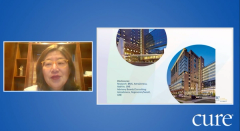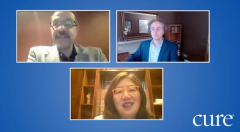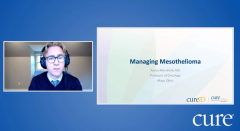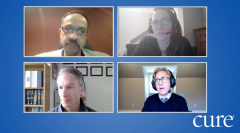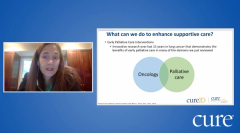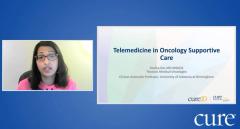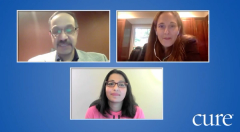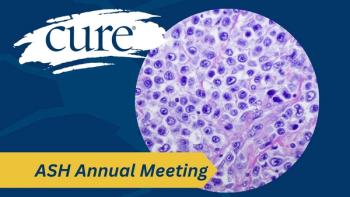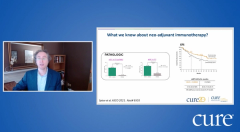
Educated Patient® Lung Cancer Summit Neoadjuvant Versus Adjuvant Therapy Presentation: October 1, 2022
Watch Dr. Jared Weiss, from UNC School of Medicine, discuss neoadjuvant versus adjuvant therapy during the CURE Educated Patient Lung Cancer Summit.
Episodes in this series

Surgery alone may not be an effective treatment approach for patients with lung cancer due to potential microscopic cancer spread — or micrometastatic disease, which opens up the conversation to using therapies before or after surgery to possibly improve the cure rate, according to an expert.
“We are accepting and recommending to patients to consider doing something more, because in a portion of patients, we can dramatically change that (rate of cancer recurrence),” Dr. Jared Weiss, professor of medicine and section chief of thoracic and head/neck oncology at UNC School of Medicine in Chapel Hill, North Carolina, told CURE®.
Not only can neoadjuvant (delivered before the main treatment) and adjuvant therapies (given after the primary treatment) potentially reduce a patient’s risk for disease recurrence, but it may also improve quality of life.
“We all wish we could just do surgery and be done. And if we couldn't make a difference, then so it would be,” Weiss said. “Now we're in an era where what we do actually makes a very meaningful difference in the probability that that person is alive down the road. And as well, it makes a massive difference in quality of life because the only thing that trashes quality of life … worse than chemotherapy is lung cancer.”
Treating Micrometastatic Disease After Surgery
During his presentation at CURE®’s Educated Patient® Lung Cancer Summit, Weiss discussed how the cure rates with surgery alone in patients with lung cancer are not that high. In patients with stage 1 disease, roughly half of patients are cured with only surgery, and for those with stage 3 disease, approximately 15% of patients are cured.
This lack of effectiveness with surgery alone in patients with lung cancer may be associated with micrometastatic disease. For example, imaging technologies are able to detect masses that are at least a centimeter to as small as even two or three millimeters. Once cancer is approximately the size of a small dot created by the tip of a pen, it may no longer be detected by modern scanners. In fact, that size represents 10 billion cancer cells, Weiss said.
“The surgeon can get all of the primary (cancer), get out all of the lymph nodes,” Weiss explained. “But if there’s already microscopic spread, spread too small to see on our best imaging to somewhere distant like the adrenal glands, liver or bone, unless your surgeon is Superman with microscopic vision, he or she cannot get it all.”
This is why medicines like chemotherapy and immunotherapy are used to remove any microscopic disease that may remain after surgery. Approaches like these are aimed to convert a patient who may not be cured with surgery alone to a patient that has been cured by removing any micrometastatic disease, Weiss said.
Anxiety may arise once patients with lung cancer learn that they have to undergo several types of treatment before it may be deemed successful.
“Nearly 100% of patients have anxiety about (undergoing more treatment before or after surgery),” Weiss said. “What sane person wouldn’t? What every patient would like — and I wish it for them — would be to walk out of the operating room and have that be it.”
Weiss added that understanding that treatment may include both surgery and therapies is a part of being realistic in one’s cancer journey.
“I wish that surgery alone did it,” he said. “If we want to fantasize, I could snap my fingers and render everyone cured. It would be amazing. But if we want to help people, we have to acknowledge reality as it actually is. … But it’s like everything else in medicine — and maybe to an extent in life — it’s risk-benefit.”
Decision Making With Pertinent Information
Several factors may determine whether a patient with lung cancer would be suitable for neoadjuvant or adjuvant therapy. For example, the decision on whether a patient should receive adjuvant therapy is dependent on the stage of their disease.
“What we know is that for patients whose cancer is node positive — has cancer involving a lymph node — and probably those that are at least four centimeters in size from the place where (the cancer) started, what doctors call the primary (cancer), that there is a survival advantage for treatments with traditional chemo,” Weiss noted.
This decision is also based on whether the patient has an actionable mutation like epidermal growth factor receptor (EGFR) and ALK, among others. The information can provide a patient’s cancer team with information on what treatment approach would be best for a patient’s disease.
Weiss emphasized the importance of cancer teams counseling patients from the beginning of their journey about micrometastatic disease. This may empower the rephrasing of adjuvant or neoadjuvant therapies to focus more on what patients can do to improve their cure.
For more news on cancer updates, research and education, don’t forget to

